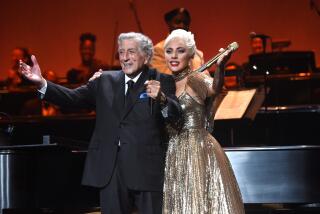TUNING IN TO QUALITY CLASSICS ON CASSETTES AND CD
- Share via
Frank Sinatra has finally arrived in the world of compact discs.
It’s hard to say who will be more elated: Sinatraphiles who have been waiting to hear the singer in the purity of CD sound or the retailers who’ll benefit from the certain sales rush.
Warner Bros. Records is releasing nine albums on CD from the nearly three dozen LPs Sinatra recorded for the company’s affiliate Reprise label. The albums, recorded between 1960 and 1973, include “The Concert Sinatra,” “It Might as Well Be Swing,” “September of My Years,” “My Way” and “Ol’ Blue Eyes Is Back.”
Though Warner officials wouldn’t discuss specific figures, a source at the company said the number of units being shipped on each of the nine titles is “unprecedented” for catalogue items (previously released material).
The figure for each CD is believed to be equivalent to the initial CD shipment for a current Top 10 album, around 40,000 to 80,000. That means about 500,000 Sinatra CDs in the stores this week. Additional albums will be released periodically until all 34 of Sinatra’s Reprise packages are in the stores. (Capitol, for whom Sinatra recorded some of his best known works in the ‘50s, is also expected to release some of them in CD, starting next year.)
And how about the music?
The release of these CDs is a timely reminder--amid the current fascination with his personal life--of what matters most about him: his artistry.
Two overall conclusions: Encouraged by the ability to control his recording career through his own company (Reprise), Sinatra in the 1960s was living through the golden years.
On the other hand, too often he seemed disturbed by the inroads of time. He was 45 when the first tracks on these nine albums were taped, and 57 at the latest session. Such albums as “September of My Years,” and the nostalgic narration in his two-disc set “A Man and His Music” indicate a premature concern.
After all, nearing his 71st birthday he has reached the November of his years, yet he retains most of the virtues that are consistently in evidence here.
Why, then, the air of finality?
Perhaps the reason was the rock revolution. Sinatra speaks of being grateful for “equal time in Beatle land,” yet along the way has no trouble tackling Lennon-McCartney’s “Yesterday,” a Jobim bossa nova, and other songs indicating that a new generation of writers could still provide him with suitable material.
The pre-digital but generally faultless sound quality renders the apology for “noise and other distortions” quite unnecessary. There are no auditory impediments to appreciation of the arrangements by Nelson Riddle, Gordon Jenkins, Don Costa and Quincy Jones. There is no loss of fidelity to cover up Sinatra’s impeccable assurance.
Perhaps it is only coincidence that the finest set of all happens also to be the earliest. Taped in 1963, “The Concert Sinatra” is flawless. All but two of the eight melodies are by Richard Rodgers and all but three have Oscar Hammerstein lyrics. No collection offering “Bewitched,” “This Nearly Was Mine,” the long “Soliloquy,” and the exquisite “Lost in the Stars” can leave much room for failure.
“It Might As Well Be Swing” (1964) finds the Count Basie band augmented by strings on six of the 10 cuts. Still, the orchestra plays the daylights out of Quincy Jones’ charts. Very little is heard of Basie, but there are muted obbligatos by Sweets Edison’s trumpet.
In the two-disc set “A Man and His Music” (1965), Sinatra reminisces about his Harry James and Tommy Dorsey days. Sy Oliver joins in the vocal on his arrangement of “The One I Love.” This is not quite a “Greatest Hits” anthology, but both parts (with 13 and 19 tunes respectively) involve his early associations. It’s ironic to hear his spoken tribute to, and even quote from, President Kennedy (recorded before the break), and intriguing to hear one cut that has no singing: “From Here to Eternity” is a re-enactment of a scene from the movie. The lead-in to “Young at Heart” has him asking: “How do I feel at 50?” though he was only 47 when that song was recorded.
“September of My Years” (1965) ranks second only to “Concert Sinatra.” The Jenkins charts for “Last Night When We Were Young,” “It Was a Very Good Year” and the other retrospective themes are a reminder of how high he ranked among the Sinatra arranger/conductors.
“That’s Life” (1966) has some of the lesser songs (including the cliche lyrics and banal melodies of “Winchester Cathedral” and “Give Her Love”), but the title tune and Andre and Dory Previn’s “You’re Gonna Hear From Me” are redeeming features.
“My Way” (1969) moves forward in its choice of songs. The simple, gentle “Didn’t We,” the easy beat of “Hallelujah I Love Her So” and the humorous nostalgia of “Mrs. Robinson” recall how well Sinatra has dealt with fresher material.
“Ol’ Blue Eyes Is Back” (1973) marked a return to the studio after a two-year retirement. The voice is a little rusty here and there, but the lower register has the same sonorous strength. The songs (four by Joe Raposo) are, with the exception of Sondheim’s “Send in the Clowns,” less than memorable. Since he was back at work, even though below optimum form, we must acknowledge that for Sinatra, and for the classic popular music he has symbolized through the decades, 1973 was a very good year.
More to Read
The biggest entertainment stories
Get our big stories about Hollywood, film, television, music, arts, culture and more right in your inbox as soon as they publish.
You may occasionally receive promotional content from the Los Angeles Times.










